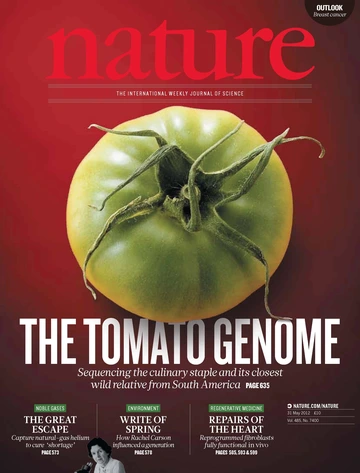UA Geneticists Help Make Tomato Genome an Open Book

An international consortium has deciphered the genetic code of the cultivated tomato and a wild relative.
The complete genetic information of the cultivated tomato and its closest wild relative, Solanum pimpinellifolium, have been sequenced by the Tomato Genome Consortium, or TGC, a group of more than 300 scientists from 14 countries.
Published as a cover story in the May 31 issue of the journal Nature, the results from this effort are expected to reduce costs and streamline efforts to improve tomato production and resistance to pests and drought.
The sequence provides a detailed overview of the functional portions of the tomato genome and its closest relative, revealing the order and structure of their 35,000 genes.
The tomato belongs to the Solanaceae (nightshade) family, which includes potatoes, peppers and eggplant, as well as ornamental or medicinal plants, such as petunia, tobacco, belladonna and mandrake. The members of this family have adapted to different ecosystems, from tropical rainforests to the extremely dry Atacama Desert in Chile.
"The tomato is an important biological model system for understanding fruit biology, ripening and crop development," said Rod Wing, who heads the Arizona Genomics Institute at the University of Arizona, which provided the physical map that made it possible to put the genetic sequence in order.
"Having the genome provides a much more precise way of bringing in genes through normal breeding and crossing techniques, and much faster than was possible before."
Wing's group specializes in building what geneticists call a physical map of a genome, a crucial foundation of any genome sequencing effort. His lab has earned a reputation for providing extremely high-quality maps, as documented in previous sequencing efforts leading to the genome sequences of rice and corn.
"If you think of the genetic information as a book, the words would refer to the sequence of the genes, and the physical map would refer to the order of the pages," explained Wing, a professor of plant sciences and a BIO5 Institute member who holds the Bud Antle Endowed Chair for Excellence in Agriculture and Life Sciences.
"Sequencing gives you three or four pages at a time, but then you have to connect those with the next three and so forth. You could say we put the pages of the book in order."
The sequence shows that the genome of tomato "triplicated" suddenly about 60 million years ago, close to the mass extinction that included the disappearance of the dinosaurs. Subsequently, most of the triplicated genes were lost, while some of those surviving one have specialized and now control important features of the plant, such as those controlling fruit characteristics, including ripening time, firmness and red pigmentation.
"For any characteristic of the tomato, whether it's taste, natural pest resistance or nutritional content, we've captured virtually all those genes," said James Giovannoni, a scientist with the Boyce Thompson Institute for Plant Research at Cornell University and the U.S. Department of Agriculture who leads the US tomato sequencing team, which includes researchers at nine universities, the USDA and Cold Spring Harbor Laboratory, where the wild tomato genome sequence was developed.
The sequence will serve as a reference for other Solanaceae species and for comparative genomic studies both within the Solanaceae and with other higher plant taxa.
Having the genome sequence will allow scientists to locate and identify genes more quickly and improve the crop more rapidly.
Strawberries, apples, melons, bananas and many other fleshy fruits share some characteristics with tomatoes, so information about the genes and pathways involved in fruit ripening can potentially be applied to them, Giovannoni said, helping to improve food quality, food security and reduce costs.
"Our map is composed of about 4,000 genetic markers – mileposts if you will – that help pinpoint a given gene's position," Wing said. "Before we had this map, you had to start from scratch and search along the DNA until you located your gene of interest. Now, the map immediately narrows the pool of candidate genes down to about 30."
According to Wing, genomic sequencing projects have revealed that organisms differ less in terms of sheer number of genes than was originally expected. The tomato is estimated to harbor about 50 percent more genes than the human genome, lined up on 12 chromosomes. The immense diversity of life appears to be much more closely related to the mechanisms regulating the activity of those genes.
Wing said he is especially excited about the tomato genome project because the fruit is his "first love" that started his career in plant science. As a postdoctoral researcher, he and Giovannoni worked in the same lab at Cornell University and then as assistant professors at Texas A&M University. Wing's research led to the identification of a gene controlling the detachment of the tomato fruit from the plant in the process of ripening, a process called abscission.
The TGC was founded in 2003 in Washington, and includes scientists from Argentina, Belgium, China, France, Germany, India, Israel, Italy, Japan, Korea, Netherlands, United Kingdom, Spain and the U.S. The genome sequence and related resources are freely accessible on the consortium's website.
Tomato genome and sequencing research in the U.S. was supported by the National Science Foundation and the USDA.
https://news.arizona.edu/story/ua-geneticists-help-make-tomato-genome-o…
Click below to read the paper:

